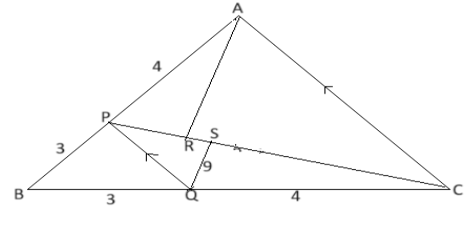Start learning 50% faster. Sign in now
Get Started with ixamBee
Start learning 50% faster. Sign in now △ ABC with P on AB such that PB: AP = 3: 4. PQ || AC. AR ⊥ PC and QS ⊥ PC. QS = 9 cm. Proportional Segments: Given – PB: AP= 3: 4, let PB = 3k and AP = 4k. Therefore, AB = PB + AP=3k =4k = 7k. Similar Triangles: Since PQ || AC, triangles △ APQ and △ APC are similar. This implies the ratio of their corresponding sides is. PB/AB=3/7 Area of △PBQ/△ABC =9/49 Ratio of △APC and △QPC- =½ ×PC×AR: ½×PC×QS =AR: QS △APC/△QPC =AR/QS … (1) Area of △PBQ=9 and △QPC =12 Now Area of △APC =△ABC –(△PBQ+△QPC) =49-(9+12) =28. From Eq-(1) 28/12 =AR/9 AR =21cm.
△ ABC with P on AB such that PB: AP = 3: 4. PQ || AC. AR ⊥ PC and QS ⊥ PC. QS = 9 cm. Proportional Segments: Given – PB: AP= 3: 4, let PB = 3k and AP = 4k. Therefore, AB = PB + AP=3k =4k = 7k. Similar Triangles: Since PQ || AC, triangles △ APQ and △ APC are similar. This implies the ratio of their corresponding sides is. PB/AB=3/7 Area of △PBQ/△ABC =9/49 Ratio of △APC and △QPC- =½ ×PC×AR: ½×PC×QS =AR: QS △APC/△QPC =AR/QS … (1) Area of △PBQ=9 and △QPC =12 Now Area of △APC =△ABC –(△PBQ+△QPC) =49-(9+12) =28. From Eq-(1) 28/12 =AR/9 AR =21cm.
Qualified audit report means:
What is the new exemption threshold for contactless card transactions under the RBI's proposed Alternative Factor Authentication for digital payments?
Under Basel III, the Liquidity Coverage Ratio (LCR) requires banks to hold high-quality liquid assets (HQLA) to meet liquidity needs for how many days ...
Which among the following is the act of taking on a risk for a fee?
AD Category – I banks are required to report all the inward remittances including advance as well as old outstanding inward remittances received for e...
Which of these are covered under Regulated Entities (RE):
1. All India Financial Institutions (AIFIs)
2. All Non-Banking Finance Companies...
The cost of capital for a firm _______.
Which of the following is an intangible asset?
The balances with bank will be categorized in which time bucket in the ALM statement?
What is the objective of the IFSCA Act?